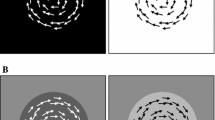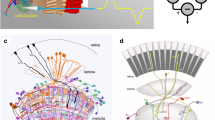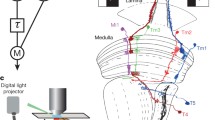Summary
-
1.
Spatial processing of visual signals in the fly's movement-detecting pathway was studied by recording the responses of directionally-selective movement-detecting (DSMD) neurons in the lobula plate. The summarized results pertain to a type of neuron which preferentially responds to horizontal movement directed toward the animal's midline. Three kinds of visual stimuli were used: moving gratings, reversing-contrast gratings and reversing-contrast bars.
-
2.
Contrast-sensitivity functions were measured for reversing-contrast gratings. With horizontally-oriented gratings, sensitivity is maximum at the lowspatial-frequency end and falls off toward high frequencies. With vertically-oriented gratings, sensitivity is maximum at an intermediate spatial frequency (Fig. 7). These results are consistent with a neural organization in which the DSMD neuron receives its input through an array of small-field (“ sampling”) units, each unit having a receptive field comprising an excitatory centre and horizontally-extending inhibitory flanks (Fig. 17).
-
3.
Threshold contrast functions were measured for reversing-contrast bars (Figs. 11 and 12). The results for horizontally-oriented bars differ from those for vertically-oriented bars in a way that is consistent with the hypothesized neural organization.
-
4.
Response to horizontally-moving, verticallyoriented gratings of various spatial frequencies were measured (Figs. 13 and 14) and the results used to infer the azimuthal angle\(\widetilde{\Delta \phi }\) between the visual axes of sampling units participating in directionally-selective movement detection (Fig. 18). At a mean luminance of 10 cd/m2, the inferred value of\(\widetilde{\Delta \phi }\) is approximately equal to the angle between the visual axes of adjacent ommatidia of a horizontal row, in the frontal eye region (Figs. 14, 18).
-
5.
When the level of ambient light is decreased, the response characteristics of the DSMD neuron change in a way which suggests that, within the eye, the neural representation of the visual scene becomes coarser than the ommatidial mosaic. When mean luminance is lowered by 3 log units (from 10 cd/m2 to 0.01 cd/m2) the altered response characteristics suggest neuronal modifications such that the excitatory centres of the sampling units' receptive fields become 50% wider (Figs. 7 and 17), the inhibitory flanks become weaker and more diffuse, and\(\widetilde{\Delta \phi }\) increases by 30% (Figs. 14 and 18). Neuronal mechanisms that might mediate such changes are proposed and discussed.
-
6.
The experimentally-measured characteristics of the DSMD neuron are compared with theoretically-predicted characteristics of an ideal movement detector, designed for optimum performance. This comparison suggests that the fly's movement-detecting pathway prefilters visual signals in such a way as to extract the most reliable movement cues, and that it analyzes the filtered information in a way that achieves maximum directional selectivity. The characteristics of the movement-detecting pathway vary with luminance in a way that ensures the best attainable performance at each level of ambient light (Fig. 21).
Similar content being viewed by others
Abbreviations
- DSMD :
-
directionally-selective movement detector
References
Arnett, D.W.: Spatial and temporal integration properties of units in first optic ganglion of dipterans. J. Neurophysiol.35, 429–444 (1972)
Barlow, H.B., Levick, W.R.: The mechanism of directionally selective units in the rabbit's retina. J. Physiol.178, 477–504 (1965)
Beersma, D.G.M., Stavenga, D.G., Kuiper, J.W.: Organization of visual axes in the compound eye of the flyMusca domestica and behavioural consequences. J. Comp. Physiol.102, 305–320 (1975)
Bishop, L.G.: A search for color encoding in the responses of a class of fly interneurons. Z. Vergl. Physiol.64, 355–371 (1969)
Bishop, L.G., Keehn, D.G.: Neural correlates of the optomotor response in the fly. Kybernetik3, 288–295 (1967)
Bishop, L.G., Keehn, D.G., McCann, G.D.: Studies on motion detection by interneurons of the optic lobes and brain of the fliesCalliphora phaenicia andMusca domestica. J. Neurophysiol.31, 509–525 (1968)
Bracewell, R.: The Fourier transform and its applications. New York: McGraw-Hill (1965)
Braitenberg, V.: Periodic structures and structural gradients in the visual ganglia of the fly. In: Information processing in the visual systems of arthropods. Wehner, R. (ed.), pp. 3–15. Berlin, Heidelberg, New York: Springer 1972
Buchner, E.: Elementary movement detectors in an insect visual system. Biol. Cybern.24, 85–101 (1976)
Buchner, E., Buchner, S., Hengstenberg, R.: Deoxy-glucose maps movement-specific nervous activity in visual ganglion ofDrosophila. Science205, 687–688 (1979)
Collett, T., King, A.J.: Vision during flight. In: The compound eye and vision of insects. Horridge, G.A. (ed.), pp. 437–466. Oxford: Clarendon 1975
Collett, T.S., Land, M.F.: Visual control of flight behaviour in the hoverfly,Syritta pipiens L. J. Comp. Physiol.99, 1–66 (1975)
Dvorak, D.R., Bishop, L.G., Eckert, H.E.: On the identification of movement detectors in the fly optic lobe. J. Comp. Physiol.100, 5–23 (1975)
Dvorak, D.R., Srinivasan, M.V., French, A.S.: The contrast sensitivity of fly movement-detecting neurons. Vision Res.20, 397–407 (1980)
Eckert, H.: Functional properties of the HI-neurone in the third optic ganglion of the blowfly,Phaenicia. J. Comp. Physiol.135, 29–39 (1980)
Eckert, H., Bishop, L.G.: Anatomical and physiological properties of the vertical cells in the third optic ganglion ofPhaenicia sericata (Diptera, Calliphoridae). J. Comp. Physiol.126, 57–86 (1978)
Enroth-Cugell, C., Robson, J.G.: The contrast sensitivity of retinal ganglion cells of the cat. J. Physiol. (London)187, 517–552 (1966)
Gavel, L. von: Die “kritische Streifenbreite” als Mass der Sehschärfe beiDrosophila melanogaster. Z. Vergl. Physiol.27, 80–135 (1939)
Geiger, G., Poggio, T.: The orientation of flies towards visual patterns: On the search for the underlying functional interactions. Biol. Cybern.19, 39–54 (1975)
Georgeson, M.A., Sullivan, G.D.: Contrast constancy: deblurring in human vision by spatial frequency channels. J. Physiol. (London)252, 627–656 (1975)
Goodman, J.W.: Introduction to Fourier optics. New York: McGraw-Hill 1968
Götz, K.G.: Behavioural analysis of the visual system of the fruitflyDrosophila. In: Proceedings of the symposium on information processing in sight sensory systems. Nye, P.W. (ed.). Pasadena: California Institute of Technology Press 1965
Hardie, R.C.: Peripheral visual function in the fly. Ph.D. Thesis, Australian National University, Canberra, Australia (1978)
Hausen, K.: Functional characterization and anatomical identification of motion sensitive neurons in the lobula plate of the blowflyCalliphora erythrocephala. Z. Naturforsch., Teil C31, 628–633 (1976)
Hubel, D.H.: Tungsten microelectrode for recording from single units. Science125, 549–550 (1957)
Kirschfeld, K.: The visual system ofMusca: Studies on optics, structure and function. In: Information processing in the visual systems of arthropods. Wehner, R. (ed.), pp. 61–74. Berlin, Heidelberg, New York: Springer 1972
Kirschfeld, K.: The visual system of the fly: physiological optics and functional anatomy as related to behaviour. In: The neurosciences: Fourth study program. Schmitt, F.O., Worden, F.G. (eds.), pp. 297–310. Massachusetts: MIT Press 1978
Laughlin, S.B.: Neural principles in the peripheral visual systems of invertebrates. In: Handbook of sensory physiology, Vol. VII/6B. Autrum, H. (ed.), pp. 133–280. Berlin, Heidelberg, New York: Springer (1980)
Laughlin, S.B., Hardie, R.C.: Common strategies for light adaptation in the peripheral visual systems of fly and dragonfly. J. Comp. Physiol.128, 319–340 (1978)
Lillywhite, P.G., Dvorak, D.R.: Responses to single photons in a fly optomotor neurone. Vision Res. (in press)
Marmarelis, P.Z., McCann, G.D.: Development and application of white-noise modeling techniques for studies of insect visual nervous system. Kybernetik12, 74–89 (1973)
McCann, G.D.: The fundamental mechanism of motion detection in the insect visual system. Kybernetik12, 64–73 (1973)
McCann, G.D.: Nonlinear identification theory models for successive stages of visual nervous systems of flies. J. Neurophysiol.37, 869–895 (1974)
McCann, G.D., Arnett, D.W.: Spectral and polarization sensitivity of the dipteran visual system. J. Gen. Physiol.59, 534–558 (1972)
Mimura, K.: Analysis of visual information in lamina neurones of the fly. J. Comp. Physiol.88, 335–372 (1974)
Pick, B.: Visual pattern discrimination as an element of the fly's orientation behaviour. Biol. Cybern.23, 171–180 (1976)
Pick, B., Buchner, E.: Visual movement detection under light- and dark-adaptation in the fly,Musca domestica. J. Comp. Physiol.134, 45–54 (1979)
Pierantoni, R.: A look into the cock-pit of the fly. The architecture of the lobula plate. Cell Tissue Res.171, 101–122 (1976)
Poggio, T., Reichardt, W.: Visual control of orientation behaviour in the fly. Part 2. Q. Rev. Biophys.9, 377–438 (1976)
Reichardt, W.: Movement perception in insects. In: Processing of optical data by organisms and by machines. Reichardt, W. (ed.), pp. 465–493. New York: Academic Press 1969
Reichardt, W.: The insect eye as a model for analysis of uptake, transduction and processing of optical data in the nervous system. In: The neurosciences, Second study program. Schmitt, F.O. (ed.), pp. 494–510. New York: Rockefeller University Press 1970
Reichardt, W.: Musterinduzierte Flugorientierung. Naturwissenschaften60, 122–138 (1973)
Reichardt, W., Poggio, T.: Visual control of orientation behaviour in the fly. Part 1. Q. Rev. Biophys.9, 311–375 (1976)
Shaw, S.: Signal transmission by graded slow potentials in the arthropod peripheral visual system. In: The neurosciences: Fourth study program. Schmitt, F.O., Worden, F.G. (eds.), pp. 275–295. Massachusetts: MIT Press 1978
Snyder, A.W.: The physics of vision in compound eyes. In: Handbook of sensory physiology, Vol. VII/6A. Autrum, H. (ed.), pp. 225–313. Berlin, Heidelberg, New York: Springer 1979
Snyder, A.W., Srinivasan, M.V.: Human psychophysics: Functional interpretation for contrast sensitivity versus spatial frequency curve. Biol. Cybern.32, 9–17 (1979)
Snyder, A.W., Stavenga, D.G., Laughlin, S.B.: Information capacity of compound eyes. J. Comp. Physiol.116, 183–207 (1977)
Srinivasan, M.V., Bernard, G.D.: A proposed mechanism for multiplication of neural signals. Biol. Cybern.21, 227–236 (1976)
Strausfeld, N.J.: Mosaic organizations, layers, and visual pathways in the insect brain. In: Neural principles in vision. Zettler, F., Weiler, R. (eds.), pp. 245–279. Berlin, Heidelberg, New York: Springer 1976
Thorson, J.: Small-signal analysis of a visual reflex in the locust. Part 2. Kybernetik3, 53–66 (1966)
Torre, V., Poggio, T.: A synaptic mechanism possibly underlying directional selectivity to motion. Proc. R. Soc. (London) Ser. B202, 409–416 (1978)
Wyszecki, G., Stiles, W.S.: Color science. New York: John Wiley 1967
Zaagman, W.H., Mastebroek, H.A.K., Buyse, T., Kuiper, J.W.: Receptive field characteristics of a directionally selective movement detector in the visual system of the blowfly. J. Comp. Physiol.116, 39–50 (1977)
Zaagman, W.H., Mastebroek, H.A.K., Kuiper, J.W.: On the correlation model: Performance of a movement detecting neural element in the fly visual system. Biol. Cybern.31, 163–168 (1978)
Zettler, F., Järvilehto, M.: Intraaxonal visual responses from visual cells and second-order neurons of an insect retina. In: Information processing in the visual systems of arthropods. Wehner, R. (ed.), pp. 217–222. Berlin, Heidelberg, New York: Springer 1972
Zettler, F., Weiler, R.: Neuronal processing in the first optic neuropile of the compound eye of the fly. In: Neural principles in vision. Zettler, F., Weiler, R. (eds.), pp. 227–236. Berlin, Heidelberg, New York: Springer 1976
Author information
Authors and Affiliations
Rights and permissions
About this article
Cite this article
Srinivasan, M.V., Dvorak, D.R. Spatial processing of visual information in the movement-detecting pathway of the fly. J. Comp. Physiol. 140, 1–23 (1980). https://doi.org/10.1007/BF00613743
Accepted:
Issue Date:
DOI: https://doi.org/10.1007/BF00613743




